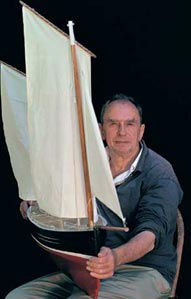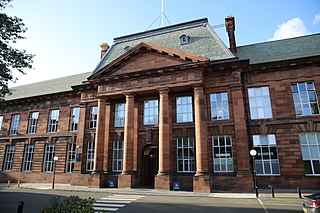
Letterboxing is an outdoor hobby that combines elements of orienteering, art, and puzzle solving. Letterboxers hide small, weatherproof boxes in publicly accessible places and distribute clues to finding the box in printed catalogs, on one of several web sites, or by word of mouth. Individual letterboxes contain a notebook and a rubber stamp, preferably hand carved or custom made. Finders make an imprint of the letterbox's stamp in their personal notebook, and leave an impression of their personal signature stamp on the letterbox's "visitors' book" or "logbook" — as proof of having found the box and letting other letterboxers know who has visited. Many letterboxers keep careful track of their "find count".

Ian Hamilton Finlay, CBE was a Scottish poet, writer, artist and gardener.
Anya Gallaccio is a British artist, who creates site-specific, minimalist installations and often works with organic matter.
Alice Thompson is a Scottish novelist.

The Scottish National Gallery of Modern Art is part of the National Galleries of Scotland, which are based in Edinburgh, Scotland. The National Gallery of Modern Art houses the collection of modern and contemporary art dating from about 1900 to the present in two buildings, Modern One and Modern Two, that face each other on Belford Road to the west of the city centre.

Edinburgh College of Art (ECA) is one of eleven schools in the College of Arts, Humanities and Social Sciences at the University of Edinburgh. Tracing its history back to 1760, it provides higher education in art and design, architecture, history of art, and music disciplines for over three thousand students and is at the forefront of research and research-led teaching in the creative arts, humanities, and creative technologies. ECA comprises five subject areas: School of Art, Reid School of Music, School of Design, School of History of Art, and Edinburgh School of Architecture & Landscape Architecture (ESALA). ECA is mainly located in the Old Town of Edinburgh, overlooking the Grassmarket; the Lauriston Place campus is located in the University of Edinburgh's Central Area Campus, not far from George Square.

Little Sparta is a garden at Dunsyre in the Pentland Hills in South Lanarkshire, Scotland, created by artist and poet Ian Hamilton Finlay and his wife Sue Finlay, since 1966.
David Macleod Black is a South African-born Scottish poet and psychoanalyst. He is author of six collections of poetry and is included in British Poetry since 1945, Emergency Kit (Faber), Wild Reckoning, Twentieth Century Scottish Poetry (Faber) and many other anthologies. As a psychoanalyst he has published many professional papers, an edited volume on psychoanalysis and religion, and a collection of essays relating to values and science.
Paul Terence Conneally is a poet, artist and musician based in Loughborough, UK.
Dalziel and Scullion are Scottish based artists. Matthew Dalziel and Louise Scullion whom have worked in collaboration since 1993, their studio creates artworks in photography, video, sound and sculpture that explore new artistic languages surrounding the subject of ecology.
The Edinburgh School of Architecture and Landscape Architecture (ESALA) is part of Edinburgh College of Art at the University of Edinburgh in Scotland. The school was ranked 5th in the UK in the 2013 Guardian University Guide and 4th in the Complete University Guide, for architecture. In 2016 Edinburgh ranked 3rd in the country for Architecture according to the Complete University Guide.
George Fiddes Watt was a Scottish portrait painter and engraver.

Art in modern Scotland includes all aspects of the visual arts in the country since the beginning of the twentieth century. In the early twentieth century, the art scene was dominated by the work of the members of the Glasgow School known as the Four, led Charles Rennie Mackintosh, who gained an international reputation for their combination of Celtic revival, Art and Crafts and Art Nouveau. They were followed by the Scottish Colourists and the Edinburgh School. There was a growing interest in forms of Modernism, with William Johnstone helping to develop the concept of a Scottish Renaissance. In the post-war period, major artists, including John Bellany and Alexander Moffat, pursued a strand of "Scottish realism". Moffat's influence can be seen in the work of the "new Glasgow Boys" from the late twentieth century. In the twenty-first century Scotland has continued to produce influential artists such as Douglas Gordon and Susan Philipsz.
Phyllis Mary Bone RSA was a 20th-century Scottish sculptor. She has the particular claim to fame as being the first female Academician of the Royal Scottish Academy. Although primarily the creator of small figurines, her works include several commissions at national level.

Dorothy Johnstone (1892–1980) was a Scottish painter and watercolourist.
Gina Czarnecki is a British artist. Her art spans a variety of mediums, including film, sculpture, installation art, and video and is frequently informed by biomedical science. She is the daughter of a Polish father and an English mother. Czarnecki currently resides in Liverpool, England.
Allan Pollok-Morris MSC FRSA is a documentary photographer, bookbinder and publisher.
Anne Finlay (1898–1963) was a Scottish artist.
Margot Sandeman was a Scottish painter, close friend of Joan Eardley and long-time collaborator with poet Ian Hamilton Finlay.

The City Art Centre is part of the Museums & Galleries Edinburgh, which sits under the Culture directorate of the City of Edinburgh Council. The City Art Centre has a collection which include historic and modern Scottish painting and photography, as well as contemporary art and craft. It is an exhibition based venue with no permanent displays.








